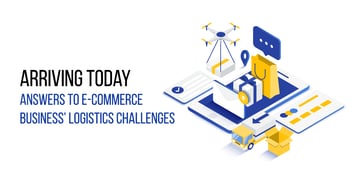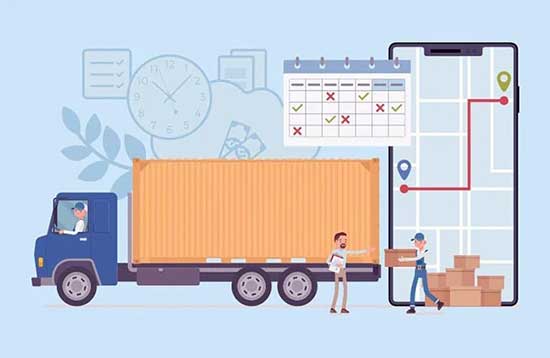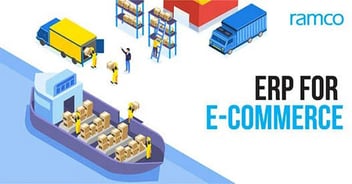

In the high-stakes world of cold chain logistics, there’s no room for error. A single degree off, a few minutes too late, or a missing data point can mean the difference between a safe, usable product and a costly, non-compliant failure. Whether transporting temperature-sensitive pharmaceuticals, frozen food, or perishable goods, the margin for mistakes is razor-thin.
As companies scale operations across multiple geographies and regulatory zones, maintaining consistent temperature control, traceability, and compliance becomes increasingly complex. Manual checks, isolated systems, and reactive processes are no longer sufficient. To drive resilience and operational excellence, businesses require real-time visibility and proactive risk mitigation, powered by intelligent logistics software.
This is where modern transportation management systems (TMS), warehouse management systems (WMS), and a robust logistics ERP step in, ensuring integrity across the cold chain at scale.
The Fragility of Cold Chain Operations
Cold chain logistics is unforgiving. A single weak link, from a failed refrigeration unit in a warehouse to a delay in cross-border customs clearance, can render entire shipments unusable. This is particularly critical in sectors like:
- Pharmaceuticals: Where maintaining precise temperature ranges during transportation is critical to preserving the safety, stability, and efficacy of drugs and vaccines.
- Food & Beverage: Where shelf life and safety standards hinge on precise thermal conditions.
- Agriculture: Where fresh produce needs quick, temperature-controlled transport to avoid spoilage.
Despite best intentions, businesses face persistent pain points in managing cold chains at scale.
Key Challenges in Cold Chain Logistics
Cold chain logistics is uniquely demanding, where precision, compliance, and responsiveness are critical at every stage. However, as businesses expand operations across multiple geographies and regulatory frameworks, several operational hurdles emerge. Here’s a closer look at the key challenges:
Limited Real-Time Temperature Monitoring
Maintaining temperature and humidity within prescribed thresholds is vital for perishable goods. Yet, many logistic providers still rely on manual checks and reporting, which offer little value when rapid action is needed. Without modern logistics software that integrates IoT sensors and real-time data feeds, deviations often go unnoticed until it’s too late, leading to spoilage, rejections, and increased operational costs.
Complex Regulatory Compliance
Industries like pharmaceuticals and food processing operate under strict national and international regulatory guidelines. Ensuring compliance requires detailed documentation, accurate data logs, and timely reporting. In the absence of a centralized logistics ERP, compiling this information from disparate systems becomes labor-intensive and error-prone. Regulatory audits, therefore, become stressful exercises rather than routine checks, exposing businesses to the risk of fines or shipment rejections.
Lack of End-to-End Traceability
Traceability is critical for product integrity, especially when handling sensitive or high-value items. Disconnected transportation management systems and warehouse management systems often lead to fragmented data across multiple platforms. This makes it difficult to track the full lifecycle of a shipment, hindering root-cause analysis during product recalls or compliance checks.
Disjointed Warehouse and Transport Operations
Cold chain logistics involves seamless coordination between storage and transport. However, when WMS software and TMS software function in isolation, it creates silos that lead to misaligned schedules, delayed dispatches, and poor utilization of fleet or storage resources. This lack of integration prevents real-time decision-making and compromises the efficiency and responsiveness of the entire supply chain.
These challenges underscore the urgent need for an integrated digital backbone that ties together the various facets of cold chain logistics. By leveraging unified logistics software platforms that incorporate both TMS and WMS, businesses can gain the visibility, control, and agility required to operate at scale.
The Case for Unified, Intelligent Cold Chain Management
To overcome these challenges, forward-thinking 3PLs are turning to next-gen logistics software powered by IoT, AI, and cloud-based platforms. At the core of this transformation lies the integration of robust transportation management systems (TMS) and warehouse management systems (WMS), tied together within a comprehensive Logistics ERP ecosystem.
Enter Ramco: A Smarter Approach to Cold Chain Logistics
Ramco Systems offers an integrated logistics software suite designed to optimize, automate, and unify cold chain operations. Here’s how it addresses the core challenges:
IoT-Based Temperature & Humidity Monitoring
Ramco leverages IoT-enabled sensors installed across transport vehicles and storage units. These devices continuously monitor temperature and humidity, feeding real-time data back to the central system.
With this feature, logistics providers can:
- Ensure cold chain integrity throughout the shipment lifecycle
- Take immediate corrective actions in case of deviations
- Avoid spoilage, rejections, and brand damage
Automated Alerts for Threshold Breaches
When environmental conditions fall outside defined thresholds, Ramco’s logistics software triggers automated alerts to relevant stakeholders, ensuring:
- Faster incident resolution
- Reduced dependency on manual checks
- Enhanced accountability
Integrated TMS + WMS for End-to-End Visibility
A true game-changer is Ramco’s unified TMS software and WMS software architecture. Instead of operating in silos, the transportation and warehouse functions seamlessly interact, ensuring:
- Optimal routing and shipment planning
- Real-time visibility into inventory status across the chain
- Synchronization of dispatch and delivery schedules
With a single platform overseeing the entire supply chain, businesses can reduce errors, cut operational costs, and improve service reliability.
Audit-Ready Data Logs & Regulatory Compliance Modules
Regulatory compliance is embedded into Ramco’s Logistics ERP framework. The system automatically logs temperature data, shipment history, and handover details, thereby creating a reliable digital audit trail.
Features include:
- Compliance dashboards tailored to global and local standards
- Configurable workflows for temperature-sensitive goods
- Automated documentation for audits, insurance, and certifications
Sustainability in Cold Chain: Reducing Spoilage and Carbon Footprint
As the global logistics industry embraces greener practices, sustainability has become a key focus area in cold chain operations. By leveraging intelligent logistics software, businesses can significantly reduce their environmental impact while enhancing efficiency. For instance:
- Maintenance alerts for refrigeration units enable predictive servicing, helping prevent energy-intensive failures and extending equipment life.
- Energy-efficient route planning minimizes fuel consumption across fleets, contributing directly to lower carbon emissions.
- Smart loading strategies ensure optimal space utilization, reducing the number of trips and improving temperature consistency, thereby cutting down spoilage and waste.
Together, these capabilities not only improve cold chain reliability but also support broader environmental goals, making sustainability a built-in outcome of operational excellence.
Why Visibility at Scale Matters
As businesses expand operations across regions and continents, cold chain logistics require scalable solutions and not just band-aid fixes. Visibility at scale means:
- Predictability: Knowing where every shipment is, its condition, and ETA.
- Accountability: Tracking who was responsible at each touchpoint.
- Agility: Responding to incidents before they escalate.
- Trust: Providing transparency to partners, regulators, and customers.
Ramco’s logistics software delivers all these capabilities within a single source of truth, something legacy systems and disconnected tools cannot offer.
Benefits Beyond Compliance
While much of the focus remains on regulatory compliance and risk mitigation, the right cold chain logistics software delivers broader business benefits:
- Operational Efficiency: Fewer manual processes, better coordination between transport and warehousing.
- Customer Satisfaction: Reliable, high-quality deliveries build trust with customers, especially in pharma and retail.
- Cost Savings: Reduced spoilage, optimized routing, and lower compliance overheads.
- Scalability: Ready to grow with your business, whether you add new regions, partners, or product lines.
- Sustainability Gains: Features like energy-efficient route planning and optimized loading strategies reduce fuel usage and carbon emissions, helping businesses align with green logistics goals.
Future-Proofing Cold Chain Logistics
The future of cold chain logistics lies in connected, intelligent ecosystems. Technologies like machine learning will enable predictive maintenance of refrigerated units. Blockchain will strengthen data integrity and trust across partners. And AI-powered forecasting will optimize resource allocation based on seasonal demand.
However, none of this is possible without a solid digital foundation, which starts with investing in a modern Logistics ERP backed by a fully integrated TMS software and WMS software solution.
Final Thoughts
Cold chain logistics is not just about moving goods from one point to another. It’s about preserving value, ensuring safety, and protecting brand integrity while meeting stringent regulatory demands. In such a high-stakes environment, visibility and compliance cannot be afterthoughts. They must be embedded into every layer of your logistics network.
Ramco’s integrated logistics software offers the tools to not only meet these challenges but turn them into competitive advantages. Whether overseeing a single cold storage unit or a global fleet of refrigerated vehicles, now is the time to modernize and future-proof your cold chain operations.
Explore Ramco's Logistics Management System to streamline operations and reduce costs.
Frequently Asked Questions (FAQs)
Enterprise asset management (EAM) involves the management of mission critical assets of an organization throughout each asset's lifecycle. EAM is used to plan, optimize, execute, and track the needed maintenance activities with the associated priorities, skills, materials, tools, and information. The aim is to optimize the quality and utilization of assets throughout their lifecycle, increase productive uptime and reduce operational costs.
Enterprise asset management (EAM) involves the management of the maintenance of physical assets of an organization throughout each asset's lifecycle. EAM is used to plan, optimize, execute, and track the needed maintenance activities with the associated priorities, skills, materials, tools, and information.
The software helps in effective maintenance of assets through preventive, predictive, shutdown and breakdown maintenance strategies. The system also helps enterprises mitigate equipment risks by enhanced safety standards. The streamlined operations and improved asset performance helps organizations increase their investment effectiveness.
EAM is important because it helps organizations track, assess, manage and optimize asset quality and reliability. Asset intensive Organizations have hundreds, thousands, even millions of assets which needs to be maintained to maximize / optimize life of these assets to increase the return on investment.
The key features of effective EAM are:
- Work management.
- Maintenance Strategies (Preventive/ Predictive / Breakdown / Shutdown).
- Planning and scheduling.
- Supply chain management.
- Health and safety.
- Mobility.
- Analytics.
- Improved Asset Health at reduced cost through data driven maintenance Programs
- Complete visibilityon entire maintenance data across Equipment, across Models, across Branches to aid in analysis & decision making such as to Repair or Replace the Equipment
- Insightful analysis of Inspection Data to improve customer satisfaction
- Effective maintenance management enhanced by predictive maintenance and inbuilt analytics
- Increased reliability and safety, keeps complete track of all the inspections & calibration schedules
- Mobile Application enables users to execute work while “in the field” leading to minimized non-productive time and increased productivity and reduces duplication of work and human errors in recording information.
- Quick turnaround time through Actionable Notification & Alerts for every process in real time and accessible anytime and anywhere.
- Improved Regulatory Part of asset management involves the implementation of better O&M practices, which can significantly improve compliance.
Asset Intensive companies under the following Industries :
- Ports
- Cement and Mining
- Utilities
- Fleet Maintenance
- Equipment Rental
- Other Manufacturing
- Real Estate & Infrastructure
- Power Generation
Contact us for a meeting and schedule a demo
This differs on case to case basis, based on the type of installation and unique industry specific requirements. Contact us for a meeting and schedule a demo.
This differs on case to case basis, based on the type of installation and unique industry specific requirements. Contact us for a meeting and schedule a demo.
Stay Connected, follow us on LinkedIn / Twitter to know more about EAM Software latest trends.


